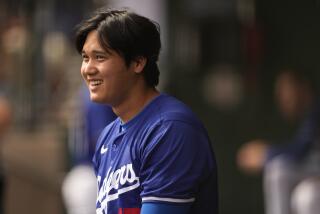Bryan Stow witness says only the Yankees had more security
A former Major League Baseball security expert testified Tuesday that opening day 2011 at Dodger Stadium boasted one of the largest security forces he had ever seen.
“The only time I saw a larger police presence was at the Yankee World Series 2009,” said Robert Campbell, a former Secret Service agent who had been employed as MLB’s liaison with the Dodgers.
The first witness called by the defense in the Bryan Stow civil trial that began three weeks ago, Campbell said he witnessed no security incidents throughout the game against the San Francisco Giants and that the Dodgers’ security command post appeared active and professional.
In a subsequent memo to MLB security, Campbell said there was one arrest involving a U.S. Marine who attempted to punch an off-duty police officer and that there were 92 ejections for “mostly alcohol-related reasons.”
Campbell said the number of ejections at games is normally 10 or less and that this proved Dodgers’ security was being proactive and aggressive.
Stow, who is now in a wheelchair after being beaten by two Dodgers fans in a stadium parking lot after the game, contends in his lawsuit that the organization’s decrease in uniformed officers led to inadequate security and an unsafe environment.
Private security at Dodger Stadium is made up of off-duty Los Angeles police officers who serve in uniform, off-duty law enforcement officers referred to as LEOs and non-sworn guards who carry a state-issued license. The two latter groups wear polo shirts.
In 2009, the Dodgers began employing fewer off-duty LAPD officers, paid $50 an hour, and more LEOs, paid $30 an hour.
Campbell said it was Ray Maytorena who decided to reduce the number of uniformed officers at the stadium. A former Secret Service agent, Maytorena oversaw the Dodgers’ security operations for two years before being fired in 2010.
“He did not believe that the uniformed LAPD officers were as responsive as the off-duty officers wearing the polo shirts,” Campbell testified. “He thought he had better production from the non-uniformed officers.”
Campbell said security on March 31, 2011, however, appeared to include a large uniformed presence.
A former LAPD lieutenant also testified that the number of LAPD officers on hand that day was significantly higher than in the previous two years.
Steven Flores helped prepare an LAPD event action plan for opening day and was present during the game.
“We had a handle on it from the very beginning,” he said.
Until Stow was beaten, Flores said, he would describe their efforts as achieving “a significant level of success in minimizing a lot of the problems we’d seen in the past considering the level of violence and rowdiness we normally see in Dodger Stadium.”
Under cross-examination, Flores said that security at Dodger Stadium began eroding in 2009, coinciding with when the Dodgers began decreasing its uniformed officers.
“We saw a significant number of crime reports coming from Dodger Stadium involving violent acts,” he said.
Flores also said that the Dodgers are primarily responsible for its stadium parking lots because they are on private land and that the organization should have provided more security for its parking lots.
Stow’s lawsuit also accuses the Dodgers of poor lighting, a subject raised with Flores.
“There was lighting in the parking lot, but it could have been better,” Flores said, adding that LAPD officers patrolling the lots on bicycles had low visibility.
Earlier in the day, Judge Victor E. Chavez rejected the defense’s motion to dismiss the suit filed on behalf of the brain-injured paramedic and his two children.
Testimony is expected to wrap up by next Tuesday, Chavez said.
More to Read
Start your day right
Sign up for Essential California for news, features and recommendations from the L.A. Times and beyond in your inbox six days a week.
You may occasionally receive promotional content from the Los Angeles Times.






